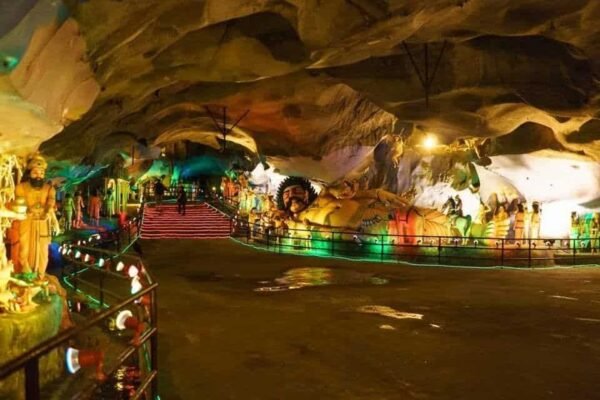Batu Caves, one of Malaysia’s most famous landmarks, is a must-visit destination for travelers seeking a blend of spirituality, culture, and natural beauty. Located just 13 kilometers north of Kuala Lumpur, this limestone hill, with its series of caves and Hindu temples, attracts millions of visitors annually. Whether you’re a solo adventurer or a curious traveler exploring Malaysia on your own, Batu Caves offers an unforgettable experience. This guide covers everything you need to know to plan a self-guided trip to this iconic spiritual site, including its history, highlights, practical tips, and why it’s a top destination for travelers in 2025.
Batu Caves – The Spiritual Significance of Batu Caves
Batu Caves is a sacred Hindu site dedicated to Lord Murugan, a deity revered in Tamil culture. The caves have been a place of worship for over a century, with the main temple, known as the Sri Subramaniam Temple, located inside the largest cave. The site’s spiritual importance peaks during the annual Thaipusam festival, held between January and February, when thousands of devotees gather to pay homage. The festival features vibrant processions, traditional music, and acts of devotion, making it a cultural spectacle for visitors.
For self-guided travelers, visiting during Thaipusam offers a unique opportunity to witness Malaysia’s rich cultural diversity. However, the caves are equally captivating year-round, with their serene atmosphere and intricate Hindu shrines. The spiritual energy of Batu Caves, combined with its historical and geological significance, makes it a standout destination for those exploring Malaysia independently.
Batu Caves – Exploring the Caves: What to Expect
Batu Caves comprises several caves, with the main attractions being the Temple Cave, Dark Cave, and Ramayana Cave. The Temple Cave, accessible via a steep climb of 272 colorful steps, is the heart of the site. As you ascend, you’ll be greeted by playful monkeys (keep your belongings secure!) and stunning views of Kuala Lumpur’s skyline. Inside the Temple Cave, you’ll find beautifully decorated altars and statues of Hindu deities, creating a peaceful yet awe-inspiring ambiance.
The Dark Cave, located at the base of the hill, is a conservation area offering guided eco-tours. These tours explore the cave’s unique ecosystem, including rare species of bats and cave-dwelling creatures. Booking in advance is recommended, as tours are limited to protect the environment. For a dose of mythology, the Ramayana Cave narrates the story of Lord Rama through vibrant murals and statues, offering a visual treat for visitors.

Batu Caves – Planning Your Self-Guided Visit
Getting to Batu Caves
Batu Caves is easily accessible from Kuala Lumpur, making it ideal for self-guided travelers. The most convenient option is the KTM Komuter train from KL Sentral to the Batu Caves station, which takes about 30 minutes and costs around MYR 2.60 (approximately USD 0.60). Alternatively, you can use ride-hailing apps like Grab for a quick and affordable ride, with fares ranging from MYR 15-25 depending on traffic. Buses are also available from Kuala Lumpur’s city center, though they may take longer due to traffic.
Best Time to Visit
To avoid crowds and the midday heat, plan your visit early in the morning, ideally between 7 AM and 9 AM. The caves are open daily from 7 AM to 8 PM, and entry to the Temple Cave is free. The Dark Cave tour requires a small fee (around MYR 35 for adults), and the Ramayana Cave charges a nominal entry fee of MYR 5. If you’re visiting during Thaipusam, expect large crowds and plan for extra travel time.
What to Bring
Malaysia’s tropical climate calls for lightweight, breathable clothing and comfortable shoes for climbing the steps. Modest attire is required, as Batu Caves is a religious site—cover your shoulders and knees, or rent a sarong at the entrance for a small fee. Bring a water bottle, sunscreen, and a hat to stay comfortable. If you plan to take photos, a good camera or smartphone is a must to capture the vibrant colors and intricate details.
 Batu Caves – Tips for a Memorable Experience
Batu Caves – Tips for a Memorable Experience
-
Respect the Culture: Batu Caves is a sacred site, so maintain a respectful demeanor. Avoid loud noises and follow temple etiquette, such as removing shoes where required.
-
Watch for Monkeys: The monkeys at Batu Caves are notorious for snatching food and small items. Keep your belongings secure and avoid feeding them.
-
Combine Your Visit: Pair your trip to Batu Caves with nearby attractions like the National Zoo of Malaysia or the Forest Research Institute Malaysia for a full day of exploration.
-
Stay Hydrated: The climb up the 272 steps can be tiring, especially in the heat. Carry water and take breaks if needed.
-
Check for Events: If you’re visiting during Thaipusam or other festivals, research the schedule in advance to plan around crowds and road closures.
Batu Caves – Why Batu Caves Should Be on Your Malaysia Itinerary
Batu Caves offers a perfect blend of spirituality, culture, and adventure, making it a top destination for self-guided travelers in Malaysia. Its proximity to Kuala Lumpur, affordable access, and rich cultural significance make it an easy addition to any itinerary. Whether you’re drawn to the spiritual ambiance, the stunning cave formations, or the vibrant Thaipusam celebrations, Batu Caves delivers an experience that’s both enriching and memorable.
For budget-conscious travelers, the low cost of visiting Batu Caves is a major draw. With free entry to the main cave and affordable transportation options, it’s an accessible destination for backpackers and solo adventurers. The site’s unique combination of natural beauty and cultural heritage also makes it a fantastic spot for photography and storytelling, perfect for sharing on social media or travel blogs.
Batu Caves – Practical Information for 2025 Travelers
As of 2025, Batu Caves remains a top attraction in Malaysia, with ongoing efforts to maintain its cultural and environmental integrity. The Malaysian government encourages sustainable tourism, so expect clear signage and guidelines to preserve the site. For the latest updates on opening hours, tour availability, or festival schedules, check official tourism websites or local travel apps before your visit.
If you’re planning a self-guided trip to Malaysia, Batu Caves is a must-see destination that encapsulates the country’s rich cultural tapestry. From the colorful steps to the serene temples, this iconic site offers an experience that resonates with travelers seeking authenticity and adventure. Pack your bags, plan your route, and get ready to explore one of Malaysia’s most cherished spiritual landmarks in 2025!
Follow us: Asia Backpack Travel
Read more:
A Budget 7-Day Thailand Backpacking Itinerary
Ultimate Guide to Everest Base Camp Trek for Backpackers
